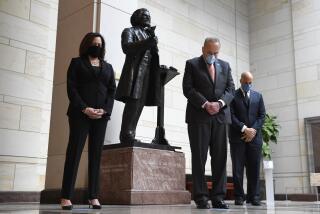Fiscal Realities Interrupt Dreams of More Police
FORT WORTH â This Texas city took account of something that many other cities did not: that a much ballyhooed federal program to put 100,000 more police officers on the beat nationwide would stop paying the costs after just three years.
So, soon after signing up for the program, city officials rounded up enough money to make sure the new officers would not just vanish when the three years were up. In fact, they helped pass a half-cent sales tax to hire even more police officers. Then they set up a dozen new patrol districts, launched a community policing program and, just two weeks ago, announced that major crimes were in an all-time decline.
Other cities, including scores in California, have not made similar preparations.
When Congress passed President Clintonâs program in 1994, it seemed to many local communities to be a dream come true. The federal government would pay for the salaries and benefits of the new officers. The departments would have to cover only the costs of training and equipping them.
But now many communities are about to reach the limit of federal funding--and they are not able to assume the costs. St. Louis officials may have to cut other police officers if they want to keep those who were hired as part of the federal program. Kansas City, Mo., police managers plan to go to City Hall soon to ask the city to slash other programs to pay for the new officers.
Los Angeles officials are looking at making city government work more âefficientlyâ in other areas in order to pay for the cops. Sacramento Police Chief Arturo Venegas said his City Council plans to place its entire budget before the public to ask the people where to find the money.
And in San Diego, police officials have already given back federal grants for 40 new officers. They simply cannot guarantee that the city will ever have the money to pay for them itself.
âI assume there will be some pockets of the nation that canât make the commitment,â said Dan Rosenblatt, executive director of the International Assn. of Chiefs of Police, headquartered in Washington.
âThat is simply part of the unfortunate result of some of their individual restraints. It may very well be that some communities default.â
How many cities manage the financial handoff will determine whether this high-profile boost for local law enforcement, which received a lot of attention during the 1996 presidential campaign, turns out to have lasting impact on urban crime or is just another well-meaning but short-lived experiment.
At a time when the federal budget can afford few open-ended subsidies for cities and their problems, the situation may also show whether the approach of providing start-up funds can work or whether it just leads to later disappointment.
*
Officials at the Justice Department, where the program is administered, said they cannot yet project how many communities are in jeopardy of default, but they are watching with great interest. The first round of local payments comes due this fall, meaning most cities must come up with the money in the annual budgets they propose this spring.
And although the communities promised to pick up the payments after three years--a pledge they made in their grant applications--Justice Department officials have not decided how the cities will be held responsible.
The worst punishment could be disqualification from future federal grant programs, said Joseph E. Brann, the programâs national director. That penalty could be a hefty price, considering how many communities depend on federal funds.
But Brann and other national officials are banking on the âvast majorityâ of the cities coming through.
âWe asked that they develop a plan, and we asked that they make a good-faith effort to do it,â said Charles Miller, a program spokesman in the Justice Department.
The $8.8-billion Community-Oriented Police Services program, or COPS, is a six-year effort begun in 1994. So far, just under 9,000 law enforcement agencies have signed up for the grants, with money authorized to hire 52,000 police officers. A total of $2.7 billion has been dispersed.
The theory is that more police on the job means more crimes prevented and more solved. And recently, the trends have been encouraging, indicating that an increase in crime isnât as inevitable as it once seemed. Preliminary Justice Department figures show that overall crime across the nation dropped in the first part of last year.
Brann, a former California police officer who worked in Santa Ana and later served as chief of the Hayward Police Department, said more police departments today can adopt community-policing strategies--patrolling beats and engaging citizens rather than just whisking by in cars--because of the additional officers.
âCops have complained that they didnât have enough resources to do that,â Brann said. âBut our program has allowed them to jump-start their community policing programs. It gets them engaged.â
*
Here in Fort Worth, officials announced striking news last month: the lowest homicide rate since 1970; 66 murders in 1996 compared with a record high of 202 a decade earlier.
Some of that may stem from national demographics--relatively fewer young people in the prime crime-committing age group. But that doesnât explain it all, city officials say.
âYou know what we learned?â asked John Kerr, president of the Fort Worth Police Officers Assn. âWe learned that it costs money to have safe streets.â
Charles Boswell, Fort Worth assistant city manager, said his city received $1.5 million in its three-year grant and hired 20 police officers. But officials decided they werenât satisfied.
The next year, in 1995, they won 60% of the vote for a new half-cent sales tax that has allowed them to hire a dozen more cops and to accumulate the money to begin paying for the 20 new officers provided by Washington.
âAll of this,â said Boswell, âincluding the federal money, played a role in getting our crime rate down.â
But where Fort Worth has succeeded, many other cities are now racing the clock to meet their three-year pledges.
Sgt. Robert Heimberger, the St. Louis police coordinator for federal grants, said his department originally was given money for 70 new officers and that 23 additional cops are supposed to be coming soon. But what is not coming through is the local money to start paying for them later this year.
âIâm concerned, and so is City Hall, that there is going to be a point where we just canât do it,â Heimberger said.
âIf weâd had the money in the first place, we would have used it ourselves to fight crime. But we didnât. And if we canât do it now, Iâm just hoping there are no legal ramifications.â
His counterpart in Kansas City, Sgt. Troy Meyer, the police supervisor for planning and research, said his department is receiving funds under a series of grants from Washington for more than 100 new officers by 1999.
He too said City Hall is aware of the big bill coming due. Some City Council members favor saving money through attrition as older officers retire. Others hope to scale back other city services.
âWhere theyâre going to come up with the money, I donât know,â Meyer said.
*
In California, 390 law enforcement agencies are participating in the COPS program. A little more than $397 million has been authorized so far to pay for 7,236 new officers. The LAPD has been authorized $124 million for 2,200 officers.
Last week, Mayor Richard Riordan urged that the city accept another full grant for $53.4 million to hire an additional 710 officers. He said Washington had indicated that Los Angeles could accept that grant now but defer receiving the money until next year. That would mean that the city wouldnât have to pick up those costs until four years from now, rather than three.
In the meantime, Keith Comrie, the city administrative officer, reported in November that there is a developing budget shortfall of more than $50 million.
So the mayorâs spokeswoman, Noelia Rodriguez, said the city is hoping to turn over to civilian workers some jobs normally handled by officers and to make other city tasks more efficient--all in an effort to save money that will be needed later.
âThe concern is, how are we going to pay for all of these additional officers after the three years are up?â she said. âWe are kind of in limbo.â
So is Police Chief Venegas in Sacramento. He accepted money for 60 new cops under two separate grants. Now he is looking to City Hall for future funds. And City Hall, with its âSacramento Decisionsâ program, is looking for public guidance on whether to raise taxes or cut services.
Venegas is optimistic that his officers will fare well. âOverwhelmingly,â he said, âif you go out and ask, they will say that this is one program they want to keep.â
(BEGIN TEXT OF INFOBOX / INFOGRAPHIC)
Where Cops Have Hit the Streets
In his 1994 State of the Union address, President Clinton pledged to put 100,000 additional police officers on the nationâs streets. Called the Community-Oriented Police Services (COPS) program, his $8.8-billion plan is a six-year effort that has now reached its midpoint.
Nationwide to date, the federal government has:
* Provided funds for just under 9,000 communities, with about 65% of the law enforcement agencies in the United States now participating.
* Authorized paying the salary and benefits of more than 52,000 new officers, with 22,000 of them now in uniform and on patrol.
* Disbursed $2.7 billion in funds to pay for the new officers.
In California, the federal government has:
* Provided funds for 390 law enforcement agencies.
* Authorized salaries and benefits for 7,236 new officers.
* Authorized $397 million for the new officers.
At the Los Angeles Police Department, the federal government has:
* Provided for the hiring of more than 2,200 officers.
* Authorized the allocation of more than $124 million to pay for them.
More to Read
Sign up for Essential California
The most important California stories and recommendations in your inbox every morning.
You may occasionally receive promotional content from the Los Angeles Times.











